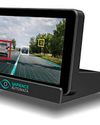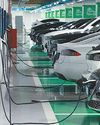The 1950s saw the introduction of automobile seat belts; in the 70s, airbags began showing up in cars.

Electronic Stability Control technology was rolled out in the late 80s. The last decade has seen the deployment of radar and camera-based back-up assist and blind-spot warning systems.
Automotive safety experts say network technology could be the next major car safety innovation. “Decades from now, it is likely, we will look back at this time period as one in which the historical arc of transportation safety will change considerably for the better, similar to the introduction of standards for seat belts, airbags, and electronic stability control technology,” said the spokesperson of a testing agency in New Delhi.
Car manufacturers, technology companies and federal regulators have worked for almost 2 decades to develop vehicle-to-vehicle (V2V) communication, which is said to be the “game-changing” technology that allows cars to communicate digitally with one another to avoid accidents. In 2016, there were an estimated 480,652 police-reported traffic crashes in which 150,785 people were killed and 494, 624 people were injured, according to the Transport Research Wing (TRW) of the Union Ministry of Road Transport and Highways. Experts say V2V technology could help avoid 70% to 80% of car accidents every year.
The road to V2V
The vision for V2V is to have a network of connected cars talking to each other, broadcasting their position, speed and status of the brakes up to 10 times per second. Vehicles would read this information about other cars on the road to calculate potential crash risks and be alerted to hazardous conditions. The car would alert the driver, or automatically engage an action, such as stopping. The same technology could power Vehicle to Infrastructure (V2I) communication, allowing cars to communicate with traffic signals to inform drivers of how much longer a light will be green, for example. Some believe this technology could be a precursor to self-driving vehicles.
هذه القصة مأخوذة من طبعة October 2017 من Auto Components India.
ابدأ النسخة التجريبية المجانية من Magzter GOLD لمدة 7 أيام للوصول إلى آلاف القصص المتميزة المنسقة وأكثر من 9,000 مجلة وصحيفة.
بالفعل مشترك ? تسجيل الدخول
هذه القصة مأخوذة من طبعة October 2017 من Auto Components India.
ابدأ النسخة التجريبية المجانية من Magzter GOLD لمدة 7 أيام للوصول إلى آلاف القصص المتميزة المنسقة وأكثر من 9,000 مجلة وصحيفة.
بالفعل مشترك? تسجيل الدخول

U.S. COMMERCE DEPARTMENT ISSUES PRELIMINARY DECISION ON TURKISH BRAKE DRUM SUBSIDIES
On December 06, 2024, the U.S. Department of Commerce announced a preliminary affirmative determination in the Countervailing Duty (CVD) investigation concerning certain brake drums imported from the Republic of Türkiye as per The Brake Report.

BHARAT MOBILITY GLOBAL EXPO 2025 THE COMPONENTS SHOW PREVIEW
The Bharat Mobility Global Expo 2025, slated for January 17-22, is ready to dazzle the world with its expansive and innovative display of automotive and mobility solutions, writes Ashish Bhatia.

INTELLIGENT TRAILERS
Today's trailer customers enjoy access to a complete range of integrated solutions, writes Ashish Bhatia.

UNLOCKING THE POTENTIAL OF USED EVS IN INDIA'S GROWING EV MARKET
India's EV market, valued at USD 2 billion, is on the fast track to becoming the third largest globally by 2025. However, maintaining this momentum will depend heavily on developing a robust second-hand EV market

SAPIENCE HARNESSES AI FOR ROAD SAFETY
Sapience Automata is banking on Al-driven ADAS innovations to curb accidents, and improve fleet efficiency, writes Upendra Kasbekar.

TRAFFIC SURVEILLANCE SOLUTIONS
CP Plus is offering innovative traffic surveillance solutions to enhance on-road safety. writes Richa Tyagi.

LEGACY BRAND RENEWED PURPOSE
As Godrej Enterprises Group celebrates its 127th anniversary, the company unveiled a bold vision to chart a sustainable and innovative path forward, writes Ashish Bhatia.

GLOBAL AUTOMOTIVE SOLUTIONS
Raghavan Sampath, Director of Business Development, India Business Development Division at MediaTek, shared the company's strategic approach of offering global automotive solutions, with Richa Tyagi.

SOUTH KOREAN BATTERY MAKERS' DECLINING SHARE
Three South Korean electric vehicle battery makers saw their combined global market share fall from a year earlier in the first 10 months of 2024 amid robust growth of Chinese rivals, industry data showed on Monday.

UNO MINDA GPT-ENABLED MUSIC SYSTEM
Uno Minda Ltd. has introduced India’s first GPT-enabled Android music system, the WTUNES-464DN-GPT, revolutionizing the in-car experience.